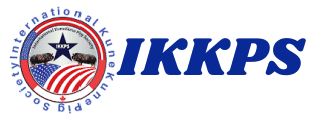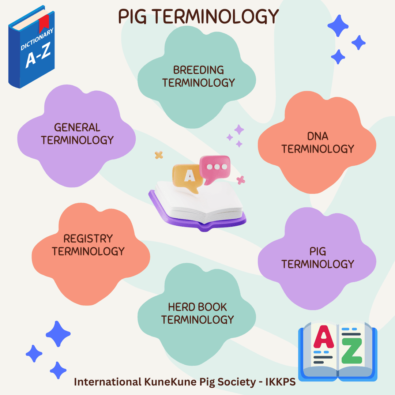
JOIN US
GET OUR KUNEKUNE
NEWSLETTER
New and highly discounted products, fresh and hot stories & useful information
KuneKune Vocabulary to help you look professional.
KuneKune Terminology
Whether you are just starting out or already on your way to breeding and raising KuneKunes, these KuneKune Terminology words may be helpful for you. Learning the correct terms will help you look more professional in your conversations with fellow KuneKune Breeders and potential buyers.

KuneKune Pig Terminology
Boar – a male pig or piglet
Barrow – neutered male
Gilt – female pig or piglet that has never had a litter of piglets
Sow – a female pig that has had offspring
Dam – mother of pigs
Sire – father of pigs
Wattle (s) – fleshy appendages attached under the jowl of a KuneKunes. First, they can have one, two or even none. Consequently, some organizations do not register pigs that do not have two wattles. Moreover, wattles can also be heard said as tassels and piri pir. Piri Piri is the term used in NZ.
Tusk - often called the canine teeth, tooth-like structures that grow from the top and bottom jaw of male pigs.
Teats - the mammary gland of a female used for piglets to nurse or suckle from.
Inverted Teats - nipples that do not stick out and usually do not produce milk
Even Teats - the same number of teats on each side of the underbelly
Blind Teats - Damaged teat that is not functioning and can be small or easily missed
Conformation - the structure of the pig as related to the Breed Standards.
Castrate - to neuter a male pig
Spay - to remove the ovaries to prevent the female from getting pregnant.
Cull - pigs that are not meant for a breeding program and are removed from the breeding and may be used as pets or pork.
Hanging Weight - the weight after a pig is ready for butchering
Harvest - utilized for pork
Lard Pig - a breed that is known for being a fatty pig
Lard - to render fat for cooking, soap, or other products
Wallow - a mud puddle
Pig Board - Often called a sorting board it is used to easily move pigs and block them from going in another direction. Used for some pig shows.
Biosecurity - a practice of safeguarding your pigs from disease and illness.
Quarantine - to put pigs in a safe area where they cannot touch or interact with other pigs. Used for new pigs to a farm or for disease control.
Marking Territory - when a male pig works their mouth to create a foam and rubs it on assorted items such as fencing, housing, or gates within their pastures.
Breeding Terminology
Offspring – baby piglets born
Farrowing Quarters - an area for female pigs to have their babies
Farrow - to birth piglets
Co-Farrow - for two or more sows to have their litters together in the same area.
Colostrum - the first milk piglets get from their mom which is high in antibodies, antioxidants, nutrients, and immunities for the piglets.
Litter - piglets born to a specific sow.
Foster - for piglets to be raised by another sow.
Creep - a safe, smaller area within the farrowing quarters to draw piglets away from mom to avoid being laid on.
Wean - to remove the mother from her piglets to allow them to eat on their own.
Progeny - the offspring of a particular pig
Estrus: a female pig in heat, the period a female pig is receptive to breeding
Prolapse - a bulging of body parts that fall out of the rectum or vagina.
Bloodline – the lineage of the pig
Line Breeding – breeding pigs that are closely related. Thus, a nicer way to say inbreeding
Inbreeding – breeding pigs that are closely related
COI – co-efficiency of inbreeding. First, it is a complex mathematical equation that assigns a number to ancestors and like ancestors within a pedigree to calculate the percentage of inbreeding. Most importantly with the IKKPS herd book, you can change the number of generations you wish to calculate this in the herd book. Likewise, you can adjust from 3 - 10 generations
AVK: Ancestor loss coefficient. AVK which means ancestor loss coefficient. First, the purpose is to measure how many ancestors occur multiple times within the documented pedigree of a pig. On one hand, if every ancestor is unique, the AVK is 100%. It would be higher if their line breeding in the past. Thus, this is a brand-new tool we are offering in our herd book. Therefore, you can adjust from 3 - 10 generations. Most importantly, since this is a new tool, we have created an in-depth article to learn more about this tool under the Info on KuneKunes Tab.
General KuneKune Terminology related to the KuneKune Registry
Call Name – the name you pick to call your pig every day
Registered name – First, this is the name IKKPS assigns your pig during a litter notification. Secondly, it consists of the breeders’ farm name or prefix + Bloodline name + how many of that line the breeder has produced of that line on their farm.
For example ABC Farms Te Whangi 12
ABC Farms is, therefore, the farm name of the breeder
Te Whangi is the bloodline of the pig
12 means that this farm has produced 12 Te Whangi pigs on their farm
Permanent Identification – the animal is permanently marked by a microchip, ear tag, or tattoo. However, IKKPS accepts all three. We do not require 840 ear tags or microchip numbers but, it is recommended. However, the pig should be permanently identified prior to leaving your farm. Consequently, if a chip or ear tag fails, please use the error correction form to notify us and we will update it as needed for you.
Identification number – the numbers of the microchip, tattoo, or ear tag. Each number is completely unique to a specific animal.
Registration Number – A unique number assigned to a pig in the registry. Registration numbers are assigned during a litter notification or when the animal is dual registered. IKKPS registration numbers start with IKKPS.
Breed Standards - Directly reflects the ideal KuneKune and the goals that breeders should strive to achieve. It reflects the characteristics of the breed, and temperament of the breed and serves as the standard of excellence in shows. The judge uses these breed standards to judge the show.
KuneKune Terminology related to UC Davis Lab
DNA Case # - starts with IKP (ours), KPS, AKB, or NCS. This is the DNA case number that UC Davis assigns to a pig that is being permanent record DNA tested or Parentage verification tested. IKKPS is IKP with UC Davis.
Permanent Record DNA Testing – Most importantly, you should not have to Permanent Record DNA test any pig that is already registered with another organization, or this should not be done on piglets. Therefore, this would not be used in general.
Parentage Verification – this is when the lab uses the dam’s and sire’s DNA on file to compare the piglet’s DNA to prove that this is the correct sire and dam.
UC Davis – the lab that performs the DNA test
MyVGL – the website that you use to enter your DNA test which is the UC Davis Lab.
Affiliation with UC Davis - by clicking the affiliation button when you enter DNA, it allows the registrar to fix any errors and saves you $5 per DNA test.
KuneKune Registry Additional Terminology
Litter notification – first, this is to inform the organization that you have had a litter. Also, the date of the piglet and individual information on each piglet. Finally, IKKPS will assign a registered name and registration number.
Transfer or Transfer of Ownership – used to move a registered pig from one person to another.
Grazing Pig – this is a non-breeding pig that may be used for harvesting, grazing grass, companionship for other animals, cleaning up orchards, or for a pet.
Harvest – to butcher for meat
Dual Register – when you use their current registration to enter a pig into another registry.
Piglet Registration – used for breeding animals. This is when a piglet has been litter notified and not yet registered.
Breeder – the person who owns the dam (female) at the time her babies are born. This person would also be listed on the registration papers as the owner of the pig.
Alt Registration #: a registration # from another registry
Vote- when members are requested to tell IKKPS how they feel about something or what they want to happen within IKKPS.
Board of Advisors – a group of people that offer their opinions or suggestions on a situation or where a decision needs to be made that did not meet the 51% of membership vote. These are professionals in various industries but, some may have been prior KuneKune breeders. To be on the board of advisors they cannot be actively breeding.
Bylaws – the rules on how IKKPS will run the organization.
Poll – same as vote. It is when members tell the organization what they want.
IKKPS Herd Book Identifiers after Registration numbers
Pending Registrations - means the piglet has been litter notified but, not yet registered.
Breeding pig - a pig or piglet that has been DNA verified parentage and met the requirements for registration.
Grazing Pig - a grazing pig, pet, or companion animal – has no breeding rights, and no litter can be registered by an animal in this class.
British Pig - this is a pig that qualifies for the British pedigree program which means all ancestors within the pedigree are all bloodlines from the UK which are Ru, BH Tutaki, Tutaki, Te Whangi, Jenny, BH Rebecca Gina, Kereopa, Sally, Trish, Rebecca Gina and Awakino
KuneKune Registry / Registries
IKKPS – International KuneKune Pig Society - this is our amazing organization. Members vote on all decisions. We are the only organization that is 100% member-driven in all areas of the organization.
AKBA – American KuneKune Breeder’s Association – the first KuneKune registry and has been renamed a couple of times with their late being IKHR
AKPR – American KuneKune Pig Registration – same as above but, was their second name. Now renamed to IKHR
IKHR – International KuneKune Hog Registry. This is their current name. This organization has changed its name three times in its history. The managers/owners make the decisions for the organization.
AKKPS - American KuneKune Pig Society - nonprofit that has a board of directors that makes most all decisions
BKKPS - The British KuneKune Pig Society is located in the UK. A big contributor to the KuneKunes in the USA.
NZKA - New Zealand KuneKune Association - the first ever KuneKune Registry and dates to the recovery efforts of the breed.
Registry Office
17500 Hamilton Arms Court Dewitt, VA 23840